
Product Components
General Power Tool Safety Warnings
Save all warnings and instructions for future reference.
The term “power tool” in the warnings refers to your mains-operated (corded) power tool or battery-operated
(cordless) power tool.
1.
Work Area Safety:
a)
b)
11
1.
2.
3.
4.
5.
6.
Saw Blade
Shoe
Chuck / Blade Clamp
LED Worklight
Handle Grip
Rotating Handle Lock Button
7.
8.
9.
10.
11.
Variable Speed Dial
Lock-On Button
Rear Handle
Trigger Switch
Locking Lever for Shoe Adjustment
WARNING: Read all safety warnings and all instructions. Failure to follow the warnings
and instructions may result in electric shock, fire and / or serious injury.
c)
Electrical Safety:
a)
b)
c)
d)
e)
f)
Personal Safety:
a)
b)
c)
d)
e)
f)
g)
Power Tool Use and Care:
a)
b)
c)
Keep work area clean and well lit. Cluttered or dark areas invite accidents.
Do not operate power tools in explosive atmospheres, such as in the presence of flammable
liquids, gases or dust. Power tools create sparks which may ignite the dust or fumes.
Keep children and bystanders away while operating a power tool. Distractions can cause you
to lose control.
Power tool plugs must match the outlet. Never modify the plug in any way. Do not use any adapter
plugs with earthed (grounded) power tools. Unmodified plugs and matching outlets will reduce the
risk of electric shock.
Avoid body contact with earthed or grounded surfaces, such as pipes, radiators, ranges and
refrigerators. There is an increased risk of electric shock if your body is earthed or grounded.
Do not expose power tools to rain or wet conditions. Water entering a power tool will increase
the risk of electric shock.
Do not abuse the cord. Never use the cord for carrying, pulling or unplugging the power tool.
Keep cord away from heat, oil, sharp edges or moving parts.
Damaged or entangled cords increase the risk of electric shock.
When operating a power tool outdoors, use an extension cord suitable for outdoor use. Use of
a cord suitable for outdoor use reduces the risk of electric shock.
If operating a power tool in a damp location is unavoidable, use a residual current device
(RCD) protected supply. Use of an RCD reduces the risk of electric shock.
Stay alert, watch what you are doing and use common sense when operating a power tool. Do
not use a power tool while you are tired or under the influence of drugs, alcohol or medication.
A moment of inattention while operating power tools may result in serious personal injury.
Use personal protective equipment. Always wear eye protection. Protective equipment such as
a dust mask, non-skid safety shoes, hard hat, or hearing protection used for appropriate
conditions require will reduce personal injuries.
Prevent unintentional starting. Ensure the switch is in the off-position before connecting to
power source and/or battery pack, picking up or carrying the tool. Carrying power tools with
your finger on the switch or energising power tools that have the switch on invites accidents.
Remove any adjusting key or wrench before turning the power tool on. A wrench or a key left
attached to a rotating part of the power tool may result in personal injury.
Do not overreach. Keep proper footing and balance at all times. This enables better control of
the power tool in unexpected situations.
Dress properly. Do not wear loose clothing or jewellery. Keep your hair, clothing and gloves
away from moving parts. Loose clothes, jewellery or long hair can be caught in moving parts.
If devices are provided for the connection of dust extraction and collection facilities, ensure
these are connected and properly used. Use of dust collection can reduce dust-related
hazards.
Do not force the power tool. Use the correct power tool for your application. The correct power
tool will do the job better and safer at the rate for which it was designed.
Do not use the power tool if the switch does not turn it on and off. Any power tool that cannot
be controlled with the switch is dangerous and must be repaired.
Disconnect the plug from the power source and / or the battery pack from the power tool before
making any adjustments, changing accessories, or storing power tools. Such preventive safety
measures reduce the risk of starting the power tool accidentally.
Store idle power tools out of the reach of children and do not allow persons unfamiliar with the
power tool or these instructions to operate the power tool. Power tools are dangerous in the hands
of untrained users.
Maintain power tools. Check for misalignment or sticking of moving parts, breakage of parts
and any other condition that may affect the power tool’s operation. If damaged, have the power
tool repaired before use. Many accidents are caused by poorly maintained power tools.
Keep cutting tools sharp and clean. Properly maintained cutting tools with sharp cutting edges
are less likely to bind and are easier to control.
Use the power tool, accessories and tool bits etc. in accordance with these instructions,
taking into account the working conditions and the work to be performed. Use of the power
tool for operations different from those intended could result in a hazardous situation.
Have your power tool serviced by a qualified repair person using only identical replacement parts.
This will ensure that the safety of the power tool is maintained.
d)
e)
f)
g)
Service:
a)
Hold power tool by insulated gripping surfaces, when performing an operation where the cutting
accessory may contact hidden wiring or its own cord. Cutting accessory contacting a “live” wire may
make exposed metal parts of the power tool “live” and could give the operator an electric shock.
It is recommended that the tool always be supplied via a residual current device with a rated residual
current of 30 mA or less.
If the replacement of the supply cord is necessary, this has to be done by the manufacturer or a
qualified agent in order to avoid a safety hazard.
Wear protective eye goggles and a protective mask when working with materials which produce large
amounts of chips or dust.
Wear a protective mask when sawing other fibrous materials.
Lock the shoe adjustment lever in place before turning the tool on.
Secure your workpiece with clamps. Always lead the power cable away from the machine towards
the rear.
Only move machine towards the workpiece when switched on.
Always hold machine with both hands and ensure that you have a safe footing while working.
Always remove the plug from the mains socket before carrying out any work on the machine.
Incorrect handling may damage the machine. Therefore always comply with these instructions.
Use only sharp saw blades which are in perfect condition; replace cracked, distorted or blunt saw blades
immediately.
Machine should only be switched on with blade installed and shoe adjustment lever locked in place.
Select tools and stroke rate according to material. Take care to maintain a constant read rate.
Do not attempt to stop the saw blade with lateral pressure after switching off.
Only use genuine accessories.
Always use the correct supply voltage. The voltage specifications on the rating plate must correspond
with the mains voltage.
Do not start the saw with the blade touching any surface. The blade action will bounce the tool and may
cause body injury.
Allow the tool to come to a complete stop before putting it down. A running tool will jerk when the blade
tip contacts any surface.
Do not let anyone under the age of 18 years operate this saw.
Always stand to one side when operating the saw and allow the blade to come to rest naturally.
When cutting round wood, use clamps to prevent the work piece from turning on both sides of the blade.
Never use your hands to remove sawdust, chips or waste close to the blade.
Rags, cloths, cord, string and the like should never be left around the work area.
Avoid cutting nails. Inspect the work piece and remove all nails and other foreign objects before sawing.
Do not attempt to free a jammed blade before first switching off the machine. Do not slow or stop a blade
with a piece of wood or other objects.
The warnings, precautions, and instructions discussed in this user manual cannot cover all possible
conditions and situations that may occur. It must be understood by the operator that common sense and
caution are factors which cannot be built into this product, but must be supplied by the operator.
Anyone using vibration tools regularly or for an extended period should first be examined by a doctor and
then have regular medical check-ups to ensure medical problems are not being caused or worsened
from use. Pregnant woman or people or have impaired blood circulation to the hand, past hand injuries,
nervous system disorders, diabetes, or Raynaud’s Disease should not use this tool. If you feel any
symptoms related to vibration (such as tingling, numbness, and white or blue fingers), seek medical
advice as soon as possible.
Do not smoke during use. Nicotine reduces the blood supply to the hands and fingers, increasing the risk
of vibration-related injury.
Wear suitable gloves to reduce the vibration effects on the user.
Use tools with the lowest vibration when there is a choice.
Include vibration-free periods each day of work.
Grip tool as lightly as possible (while still keeping safe control of it). Let the tool do the work.
To reduce vibration, maintain the tool as explained in this manual. If any abnormal vibration occurs, stop
use immediately.
2.
3.
4.
5.
Safety Instructions for Reciprocating Saw
When using electric tools, basic safety precautions should always be followed to reduce the risk of fire,
electric shock and personal injury. Read all these instructions before attempting to operate this product and
save these instructions.
The machine must not be damp and must not be operated in a wet environment. Always inspect the cable
and plug before using machine. Only have damage repaired by a qualified professional. Only insert the plug
into the mains socket when the machine is switched off. Wear protective gloves and sturdy footwear.
●
●
●
●
●
●
●
●
●
●
●
●
●
●
●
●
●
●
●
●
●
●
●
●
●
●
●
Vibration Safety
This tool vibrates during use. Repeated or long-term exposure to vibration may cause temporary or permanent
physical injury, particularly to the hands, arms and shoulders. To reduce the risk of vibration-related injury:
1.
2.
3.
4.
5.
6.
7.
Pre-Operation
Changing / Fitting a Saw Blade
- 01 -
1.
2.
3.
Shoe Adjustment
1.
2.
3.
Rear Handle Adjustment
1.
2.
3.
LED Worklight
Operation
Switching ON & OFF
Note: The trigger switch of this reciprocating saw features variable speed control.
Switching ON:
1.
2.
Switching OFF:
1.
Continuous Operation:
1.
2.
Operation (Cont.)
General Cutting
1.
2.
3.
4.
To turn ON: Press the Lock-On Button (8) after the Trigger Switch (10) is fully pressed (Fig.6), then remove
your finger off the Trigger Switch (10) – the reciprocating saw will be under continuous running status.
To turn OFF: Fully press the Trigger Switch (10) and the Lock-On Button (8) will spring up back to its
original position, then remove your finger off the Trigger Switch (10).
Install the Blade and adjust the Shoe for the job.
Press and release the Trigger to ensure that the Lock-On Button is off.
Plug the power cord into a mains power outlet.
Make sure the Blade is clear of any foreign material and the power cord or extension cord are out of the
path of the Blade.
Ensure that the material to be cut is held firmly. Small work pieces should be securely clamped in a vice
or clamped to the work bench.
Mark out a cutting line.
To begin sawing, grip the saw firmly with both hands and away from you. Rest the front of the Shoe on
your workpiece with the blade above the workpiece.
Switch on the tool and wait until the saw has reached its full speed before touching the work material.
Guide the saw blade into the workpiece.
For continuous cutting, press the Lock-On Button (8) after the Trigger Switch (10) is fully pressed , then
remove your finger off the Trigger Switch (10).
Allow the saw to come to a complete stop before setting it down.
To prevent accidents, turn off the saw and disconnect the plug from the mains power supply after use.
Clean and store the tool indoors out of children’s reach.
Install a metal cutting blade (included).
Coat the cutting surface with cutting oil to prevent the blade from overheating.
Follow the general cutting procedures found on page 15.
5.
6.
7.
IMPORTANT: Do not start the saw if the blade is in contact with anything before operation.
8.
9.
10.
11.
12.
Metal Cutting
Metals such as sheet steel, pipe, steel rods, aluminium, brass and copper can be cut with your saw. Be
careful not to bend or twist the blade and do not force the cutting action.
We recommend that you use cutting oil to lubricate the cutting surface when sawing soft metals and steel.
It keeps the blade cooler and prolongs blade life.
When cutting conduit pipe or angle iron, clamp the work in a vice if possible and cut close to the vice.
To cut thin sheet metal, sandwich the sheet between hardboard or plywood and clamp layers to prevent
vibration and the tearing of the metal.
1.
2.
3.
Maintenance, Cleaning, Storage
1.
2.
This machine has been designed to operate over a long period of time with a minimum of maintenance.
Continuous satisfactory operation depends upon proper machine care and regular cleaning.
If the supply cord is damaged, it must be replaced by the manufacturer or a qualified electrician in order to
avoid a hazard.
General Inspection
1.
2.
Cleaning:
●
●
●
Storage:8
Store the reciprocating saw in a safe, clean, and dry location out of the reach of children.
Save this instruction manual for future reference.
Technical Specifications
Manual Version 1.0, Issue Date: 08/2015
Disposal Instructions
Keep the ventilation slots of the tool unclogged and clean at all times to prevent overheating of the
engine. Regularly clean the tool’s air vents with compressed dry air.
Regularly clean the machine housing using a soft cloth, preferably after each use. If the dirt does not
come off, use a soft cloth moistened with soapy water. Never use solvents such as petrol, alcohol,
ammonia water, etc. These solvents may damage the plastic parts.
Regularly inspect all mounting screws and ensure that they are properly tightened.
Regularly clean the air vents of the tool.
Wipe clean with a dry cloth. Do not use solvents, water or chemicals to clean your power tool.
Do not immerse any part of the grinder in liquids.
Keep the motor ventilation slots clean. Keep all working controls free of dust.
Premium Reciprocating Saw
RPRS01A


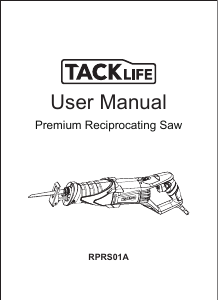

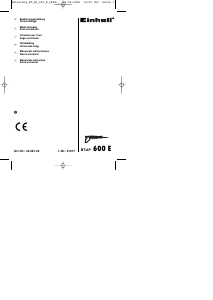
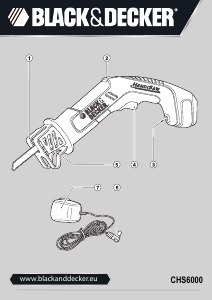
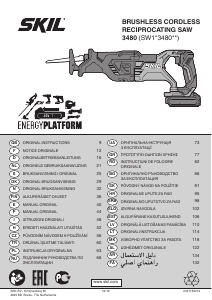
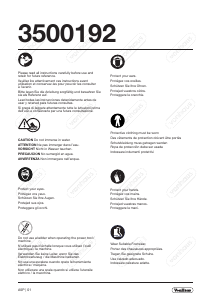
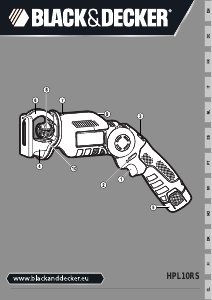
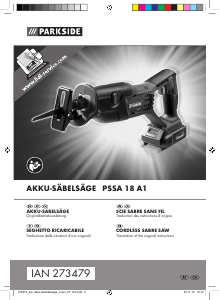
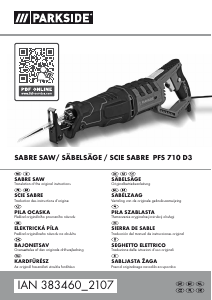
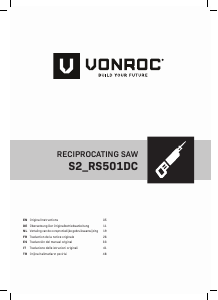
Partecipa alla conversazione su questo prodotto
Qui puoi condividere cosa pensi di Tacklife RPRS01A Sega universale. Se hai una domanda, leggi prima attentamente il manuale. La richiesta di un manuale può essere effettuata utilizzando il nostro modulo di contatto.
rispondi | È stato utile (1) (Tradotto da Google)
rispondi | È stato utile (0) (Tradotto da Google)